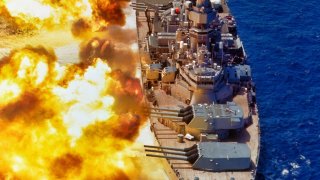Britain’s Dreadnought-class Battleship May Have Been the Best Ever
Today, Britain is a medium-sized power in rapid decline. Back in the days of the Dreadnought-class, she was still the most important nation on the planet. And the great Dreadnought-class was proof of that reality.
The genesis of the Dreadnought-class battleship was rooted in the naval arms race between the major European powers, notably between the old British Empire and Germany.
The legendary British Admiral Sir John Fisher was the mind behind the Dreadnought. He sought to make all previous battleships obsolete by designing the ship to have unprecedented firepower, speed, and armor. This battleship represents an essential evolution in warship design in the early twentieth century.
Launched in 1906, the Dreadnought was ahead of its time.
Radical Notions
For instance, unlike previous battleships were armed with mixed calibers of weapons. The Dreadnoughts, however, were armed only with large-caliber guns. Indeed, its main battery was made of ten, 12-inch guns. These large guns could fire at long ranges which also enhanced the offensive heft of the iconic Dreadnought-class.
Meanwhile, these boats employed steam-powered turbines instead of the traditional reciprocating engines. As a result, the Dreadnought could cruise at higher speeds. Because of these changes, the Dreadnought-class was faster than any battleship that came before it.
The arrival of the Dreadnought-class, it forced a complete reappraisal of naval strategy. For starters, navies around the world began building similar all-big-gun battleships. This shift forced other nations into a costly shipbuilding craze to maintain parity with their rivals.
As for how the Dreadnought-class would change tactical engagements, all one need do is look at the emphasis placed on “line-ahead” battle formations. In these formations, warships could leverage their main guns in broadside salvos. Because of this, battleship aficionados may remember the notion of “crossing the T.” Making the physical appearance of a T being created by one battleship being crossed by a rival one, this formation allows for the attacker to bring maximum firepower to bear while the enemy battleship was essentially unable to do the same.
The Arms Race That Defined the First Half of the Twentieth Century
In terms of the arms race between Germany and the British Empire, defined the pre-World War I environment. Each of the two nations committed themselves to outbuilding the other in terms of capital ships. The British spent gobs of money and time mass-producing the Dreadnought-class.
Indeed, the arms race played heavily into Britain’s ultimate, disastrous decision to enter WWI.
Ancillary to the Anglo-German naval arms race, the United States, another growing power of the day, along with the Empire of Japan far away in the Pacific Ocean, both began their own naval arms buildup. The U.S. embarked upon its shipbuilding program which led to the construction of warships like the USS South Carolina (BB-26).
This warship, in turn, influenced future American battleship designs.
The Imperial Japanese Navy, meanwhile, created its line of Dreadnought-like warships. These boats would form a key strategic element of Japan’s surface warfare fleet for the duration of its existence.
The Last Gasp of the British Empire
For centuries, British imperial naval power defined the world order. The construction of the Dreadnought-class utterly upended previous assumptions and design styles of all battleships from then on.
Today, Britain is a medium-sized power in rapid decline. Back in the days of the Dreadnought-class, she was still the most important nation on the planet. And the great Dreadnought-class was proof of that reality.
About the Author
Brandon J. Weichert, a National Interest national security analyst, is a former Congressional staffer and geopolitical analyst who is a contributor at The Washington Times, the Asia Times, and The-Pipeline. He is the author of Winning Space: How America Remains a Superpower, Biohacked: China’s Race to Control Life, and The Shadow War: Iran’s Quest for Supremacy. His next book, A Disaster of Our Own Making: How the West Lost Ukraine, is available for purchase wherever books are sold. Weichert can be followed via Twitter @WeTheBrandon.
Image Credit: Creative Commons and/or Shutterstock.


